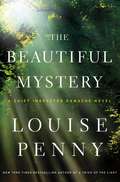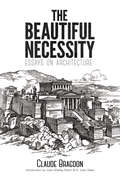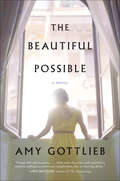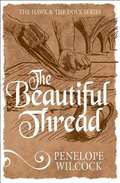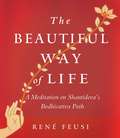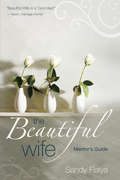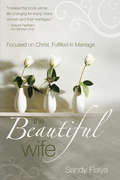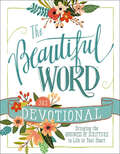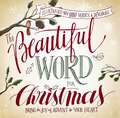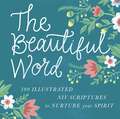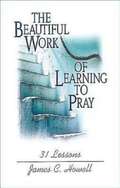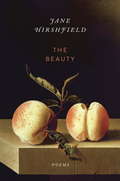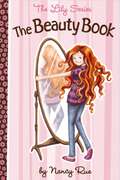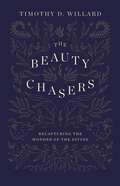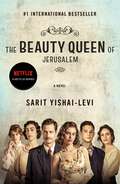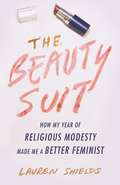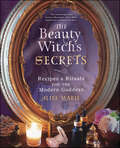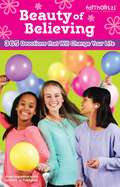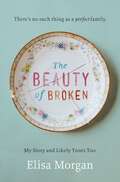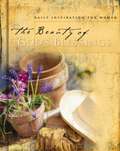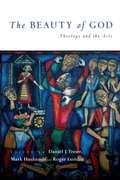- Table View
- List View
The Beautiful Mystery (Chief Inspector Gamache #8)
by Louise PennyAfter the renowned choir director at a secluded monastery hidden deep in the wilderness of Quebec is murdered, the lock on the monastery's massive wooden door is drawn back to admit Chief Inspector Armand Gamache and Jean-Guy Beauvoir of the Surete du Quebec.
The Beautiful Necessity: Essays on Architecture
by Joan Shelley Rubin Claude Bragdon A Joan SaabA noted American architect of the early twentieth century discusses universal principles behind the harmonious forms and proportions of ancient and modern buildings. Seven essays by Claude Bragdon offer a master class in the architectural union of art, beauty, and science. His observations and analyses encompass a tremendous variety of buildings, from Gothic cathedrals to Giotto's Campanile to the Taj Mahal, and his examples extend far beyond architecture to the natural symmetry found in the feathers of a peacock's tail, snowflakes, plants, and the human face."Art in all its manifestations is an expression of the cosmic life," notes the author, "and its symbols constitute a language by means of which this life is published and represented. Art is at all times subject to the 'Beautiful Necessity' of proclaiming the 'world order'." Bragdon's theories are illuminated by his graceful black-and-white line drawings, which portray the essentials of line and proportion as expressed in many well-known buildings and paintings.
The Beautiful Possible: A Novel
by Amy Gottlieb“Deeply felt and evocative. . . . Alive with characters and unafraid to examine ambiguous emotional complexities, this a moving debut.” —Meg Wolitzer, New York Times bestselling author of The Interestings and BelzharSpanning seventy years and several continents, this epic, enthralling novel tells the braided love story of three unforgettable characters. In 1946, Walter Westhaus, a German Jew who spent the war years at Tagore’s ashram in India, arrives at the Jewish Theological Seminary in New York City, where he meets Sol Kerem, a promising rabbinical student. A brilliant nonbeliever, Walter is the perfect foil for Sol’s spiritual questions—and their extraordinary connection is too wonderful not to share with Sol’s free-spirited fiancée Rosalie. Soon Walter and Rosalie are exchanging notes, sketches, and secrets, and begin a transcendent love affair. Months later they shatter their impossible bond, retreating to opposite sides of the country—Walter to pursue an academic career in Berkeley and Rosalie and Sol to lead a congregation in suburban New York. A chance meeting years later reconnects Walter, Sol, and Rosalie—catching three hearts and minds in a complex web of desire, heartbreak, and redemption“I’ve never read anything quite like this lyrical and infinitely wise novel. . . . If books could shimmer, this one would.” —Elizabeth Berg, author of The Dream Lover“[A] meditation on faith and religion, on love and faithfulness, on feminism, on the times in which the characters lived, and on the meaning of life . . . a truly satisfying novel.” —San Francisco Book Review“An ambitious study of faith, doubt, and desire both erotic and spiritual.” —Kirkus Reviews
The Beautiful Pretender
by Melanie DickersonAfter inheriting his title from his brother, the margrave has two weeks to find a noble bride. What will happen when he learns he has fallen for a lovely servant girl in disguise? The Margrave of Thornbeck has to find a bride, fast. He invites ten noble born ladies who meet the king's approval to be his guests at Thornbeck Castle for two weeks, a time to test these ladies and reveal their true character. Avelina has only two instructions: keep her true identity a secret and make sure the margrave doesn't select her as his bride. Since the latter seems unlikely, she concentrates on not getting caught. No one must know she is merely a maidservant, sent by the Earl of Plimmwald to stand in for his daughter, Dorothea. Despite Avelina's best attempts at diverting attention from herself, the margrave has taken notice. And try as she might, she can't deny her own growing feelings. But something else is afoot in the castle. Something sinister that could have far worse--far deadlier--consequences
The Beautiful Soul of John Woolman, Apostle of Abolition
by Thomas P. SlaughterA biography of the famous eighteenth-century Quaker whose abolitionist fervor and spiritual practice made him a model for generations of AmericansJohn Woolman (1720–72) was perhaps the most significant American of his age, though he was not a famous politician, general, or man of letters, and never held public office. A humble Quaker tailor in New Jersey, he became a prophetic voice for the entire Anglo-American world when he denounced the evils of slavery in Quaker meetings, then in essays and his Journal, first published in 1774. In this illuminating new biography, Thomas P. Slaughter goes behind those famous texts to locate the sources of Woolman's political and spiritual power. Slaughter's penetrating work shows how this plainspoken mystic transformed himself into a prophetic, unforgettable figure. Devoting himself to extremes of self-purification—dressing only in white, refusing to ride horses or in horse-drawn carriages—Woolman might briefly puzzle people; but his preaching against slavery, rum, tea, silver, forced labor, war taxes, and rampant consumerism was infused with a benign confidence that ordinary people could achieve spiritual perfection, and this goodness gave his message persuasive power and enduring influence. Placing Woolman in the full context of his times, Slaughter paints the portrait of a hero—and not just for the Quakers, social reformers, labor organizers, socialists, and peace advocates who have long admired him. He was an extraordinary original, an American for the ages.
The Beautiful Thread (Hawk and the Dove #8)
by Penelope WilcockWilliam de Bulmer, no longer a monk, but still a most capable administrator, returns to St Alcuins to help the new cellarer manage the challenges of a big society wedding. But this event, fraught with difficult relationships, coincides with their regular Bishop's Visitation. William tries to conceal his presence from Bishop Eric, who wants to bring him to justice for the felony of breaking his monastic vows and the grave sin of attempting suicide. Astute and zealous, the bishop sets out to hunt William down. Meanwhile the arrival of Brother Conradus's mother brings problems of a completely different nature. . . As the story unfolds, a beautiful thread of loving-kindness weaves quietly through the contrasting colours of human frailty, religious zeal, and social pretension.
The Beautiful Way of Life
by Rene FeusiEnter into the presence of a wise Buddhist master through this modern distillation of a spiritual classic.The most enduring and widely read spiritual work to emerge from Buddhism's classical age in India is surely Shantideva's Bodhisattva Way of Life. Among its many fans is the Dalai Lama, who quotes from it frequently. Here much-loved monk and meditator Rene Feusi distills Shantideva's masterpiece verse by verse. Reflecting both the lyricism of the original verses and their wealth of inspiring reflections on the virtues to be cultivated by bodhisattvas, The Beautiful Way of Life is a brilliant condensation of a masterpiece and a lucid entryway into timeless insights. Feusi also provides tips for using the verses in a series of guided contemplations.
The Beautiful Wife Mentor's Guide
by Sandy RalyaBeautiful Womanhood is a nonprofit Christian ministry whose mission is to strengthen marriages by equipping marriage mentors, encouraging women in their role as wives, and helping women build loving, godly, and supportive relationships with other wives. Since 2003, women have been coming together through Beautiful Womanhood small groups, where they gain insight from Sandy Ralya's teaching, personal guidance from a marriage mentor, and support from a loving community of women in order to realize God's plan for them. In each small group, a marriage mentor meets with small group members and leads the group through a discussion of the book.The Beautiful Wife Mentor's Guide offers:*instructions on how to implement Beautiful Womanhood small groups*guidance on becoming a confident marriage mentor*hostess tips to simplify hospitality for God's glory*chapter summaries to highlight main discussion topics*discussion icebreakers and cues to keep the conversation focused and lively*directions on how to incorporate free resources found on www.beautifulwomanhood.comBeautiful Womanhood Seminars Churches or community groups are invited to host a seminar or retreat led by author and speaker, Sandy Ralya. Specifically and individually designed to each church's needs, the seminar can train incoming mentors, excite new mentees, offer breakout sessions to discuss specific issues, and encourage the development of small group communities for wives. For more information, visit www.beautifulwomanhood.com.
The Beautiful Wife: Focused on Christ, Fulfilled in Marriage
by Sandy RalyaThe Beautiful Wife uses these inspiring stories along with biblical principles to guide and encourage any wife looking for God's best in her marriage. The Beautiful Wife answers serious questions women have about their roles as wives. Discussing everything from romance and money to beauty, communication, and sex, Sandy challenges women to open up and share their journeys so that together they can see God's plan for their marriages. "It is my passion to help women discover God's heart for their marriage, just as the other women helped me," writes Sandy. "When women share with each other the details of their journeys with God as wives, it's a beautiful thing indeed."
The Beautiful Word Devotional: Revealing the Goodness of Scripture (Beautiful Word)
by ZondervanAre you a busy woman looking for a devotional that addresses real-life questions and real-life issues? The Beautiful Word Devotional is a 365-day devotional that nurtures your spirit and encourages your heart as God's Word washes over you with its promises. With quick daily reminders and encouraging words, The Beautiful Word Devotional includes:182 verses illustrated in gorgeous full colorA daily short scripture, devotional commentary, and a short prayerThis 365-day devotional is perfect for:Women of all agesA personal purchase or gift--Mother's Day, birthdays, wedding showers, and holiday giftingThe Beautiful Word Devotional will refresh your heart daily as you seek to enjoy God's Word in a creative way. If you enjoy The Beautiful Word Devotional, check out the Beautiful Word Bible.
The Beautiful Word for Christmas (Beautiful Word)
by Mary E DemuthToday in the town of David a Savior has been born to you; he is the Messiah, the Lord.Luke 2:11 Read the Christmas story like never before with favorite scriptures hand-lettered and illustrated. Celebrate the wondrous birth of Christ with 31 devotionals that will point each day to the Savor.Savor the season with The Beautiful Word for Christmas.***This book includes:23 Bible passages illustrated in full color31 timely devotions written especially for the Christmas seasonActivities to bring the heart of the season home
The Beautiful Word: Revealing the Goodness of Scripture (Beautiful Word)
by Zondervan100 Illustrated NIV Verses That Reveal the Goodness of ScriptureThrough beautifully hand-lettered and illustrated Bible verses, The Beautiful Word will inspire you with the hope found in Scripture.One hundred Bible passages are taken from the New International Version®, including many treasured favorites, such as Jeremiah 29:11 and Philippians 4:13. With a short, though-provoking reflection alongside each illustrated Scripture, this highly designed gift book makes a lovely companion to the Beautiful Word Bibles.From Genesis to Revelation, the inspired words of God are beautiful.
The Beautiful Work of Learning to Pray: 31 Lessons
by James C. HowellPrayer is not easy, yet learning to pray can be learned. The Beautiful Work of Learning to Pray is a brief but probing guide into the life of prayer. James Howell examines the many barriers to prayer (such as our busyness, how uncomfortable with silence we are, our doubts and fears) and invites the reader to take a fresh approach to the devotional life. Each lesson begins with a scripture passage and the author draws comfortably and appropriately from a rich array of other sources (Annie Dillard, St. Augustine, Henri Nowen, Kathy Mattea, Madeleine L’Engle, Dietrich Bonhoeffer, St. Francis, Oscar Romero, and the movie Good Will Hunting are a sampling.) The author’s own engaging writing style, including his ability to illumine his ideas with the shared wisdom of others, is a major strength of this book. While each “lesson” is only two book pages long, the author draws from a deep well of wisdom about prayer. Howell leads the reader through the “subjects” of prayer (e.g. praise, confession, giving thanks), and digs deeply into theological issues such as whether prayer works, prayer and suffering, and forgiveness. According to the author, “In the end, prayer draws us into community with others-- out of our “curved in” lives and into the world in service.” The Beautiful Work of Learning to Pray will be helpful to the novice in spiritual life as well as long-time Christians who are striving for a more profound relationship with God. Includes Study Guide, List of Sources, and Scripture Index.
The Beauty
by Jane HirshfieldThe Beauty, an incandescent new collection from one of American poetry's most distinctive and essential voices, opens with a series of dappled, ranging "My" poems--"My Skeleton," "My Corkboard," "My Species," "My Weather"--using materials sometimes familiar, sometimes unexpected, to explore the magnitude, singularity, and permeability of our shared existence. With a pen faithful to the actual yet dipped at times in the ink of the surreal, Hirshfield considers the inner and outer worlds we live in yet are not confined by; reflecting on advice given her long ago--to avoid the word "or"--she concludes, "Now I too am sixty. / There was no other life." Hirshfield's lines cut, as always, directly to the heart of human experience. Her robust affirmation of choice even amid inevitability, her tender consciousness of the unjudging beauty of what exists, her abiding contemplation of our moral, societal, and biological intertwinings, sustain poems that tune and retune the keys of a life. For this poet, "Zero Plus Anything Is a World." Hirshfield's riddling recipes for that world ("add salt to hunger"; "add time to trees") offer a profoundly altered understanding of our lives' losses and additions, and of the small and larger beauties we so often miss. From the Hardcover edition.
The Beauty Book
by Nancy RueThe Beauty Book offers cool information about everything from great hair to tattoos, plus much more. But most important, the message that God-confidence is beautiful is highlighted on each and every page. "Excellent for Homeschool Use"
The Beauty Book (The Lily Series)
by Nancy RueLearn with Lily and her friends just what it means to be beautiful in God's eyes--inside and out!In a society so focused on the idea that external beauty reigns supreme, it can be difficult for young girls to figure out what "true" beauty is all about. This unique and creative book for girls ages 7-11 answers the common questions girls ask during this often confusing and overwhelming stage in their lives in an inviting and conversational manner.Filled with fun quizzes, imaginative activities, and cool illustrations, The Beauty Book offers cool, relevant information about everything from great hair styles to tattoos, from skin care to clothes, and much more. Above all, the message that God-confidence is beautiful is highlighted on each and every page.
The Beauty Chasers: Recapturing the Wonder of the Divine
by Timothy D. WillardCan we afford to chase beauty in a world that emphasizes distraction and naked ambition over a lifestyle of wonder and spiritual restfulness?The everyday road of life is littered with the pains of growing up, loving and failing to love, of peace and discord. What is God saying through all the muck of life? God speaks to us through beauty. But to hear his words, we must slow down and listen with our hearts.What would happen if we slowed down and looked at the world and our lives with new eyes? The Beauty Chasers shows us a secret passageway that leads beyond the utility mindset that banished beauty from our hearts. Author Tim Willard gives us a guidebook for discovering how to see the world with fresh eyes and let beauty guide us in life and our relationship with God.The Beauty Chasers will...inspire you to live life as a participant instead of a spectator.guide you toward a life of presence rather than distraction.give you permission to slow down and drink from the well of spiritual rest.refresh your perspective on the "wonder-full" ways of God. help you live like beauty matters.Are you ready to live life to a different cadence? Do you find yourself longing to recapture the wonder in your spiritual journey? Are you willing to walk the path less traveled? If so, then read on, friend.
The Beauty Of Spiritual Language: Unveiling The Mystery Of Speaking In Tongues
by Jack HayfordJack Hayford’s approach to speaking in tongues doesn’t fit the stereotype. Revised and expanded with new content. People often think speaking in tongues is either gibberish or emotional exuberance. They think it is strange, dramatic, or sometimes excessive. Even among Spirit-filled communities, there is disagreement over the importance of tongues. Pastor Jack makes a persuasive case for accepting tongues as a normal part of a Christian’s experience. In sensible, biblical terms he reaches across denominational lines to explain this intimate encounter with the heart of God. This revised and expanded edition includes fourteen never-before published lessons from Pastor Jack. "synopsis" may belong to another edition of this title.
The Beauty Queen of Jerusalem: A Novel
by Anthony Berris Sarit Yishai-LeviThe #1 International Best Seller!The Beauty Queen of Jerusalem is a dazzling novel of mothers and daughters, stories told and untold, and the ties that bind four generations of women.Gabriela's mother Luna is the most beautiful woman in all of Jerusalem, though her famed beauty and charm seem to be reserved for everyone but her daughter. Ever since Gabriela can remember, she and Luna have struggled to connect. But when tragedy strikes, Gabriela senses there's more to her mother than painted nails and lips.Desperate to understand their relationship, Gabriela pieces together the stories of her family's previous generations--from Great-Grandmother Mercada the renowned healer, to Grandma Rosa who cleaned houses for the English, to Luna who had the nicest legs in Jerusalem. But as she uncovers shocking secrets, forbidden romances, and the family curse that links the women together, Gabriela must face a past and present far more complex than she ever imagined.Set against the Golden Age of Hollywood, the dark days of World War II, and the swinging '70s, The Beauty Queen of Jerusalem follows generations of unforgettable women as they forge their own paths through times of dramatic change. With great humor and heart, Sarit Yishai-Levi has given us a powerful story of love and forgiveness--and the unexpected and enchanting places we find each.
The Beauty Suit: How My Year of Religious Modesty Made Me a Better Feminist
by Lauren ShieldsA young feminist finds herself questioning why "hotness" has become necessary for female empowerment--and looks for alternatives.Looking good feels good. But in a society where looking good is posited as being strong, while negotiating for better pay is statistically proven to damage our careers, is it fair to say that wicked eyeliner, weekly blowouts, and a polished Instagram feed are the keys to our liberation? If so--if "hot" really is a good enough synonym for "empowered"--why do so many of us feel, deep in our bones, that the sexy-as-strong model is a distraction? Is "pretty" still the closest to power women can get? Why is looking fierce an acceptable substitute for living in a world where women are safe?Inspired in seminary by American Muslimahs who wear the hijab for feminist reasons, Lauren Shields took off what she calls the Beauty Suit--the "done" hair, the tasteful and carefully applied makeup, the tight clothes and foot-binding shoes--for nine months. She'd really only wanted to do an experiment. Instead, her life--especially her views on what constitutes "liberation"--changed forever.Rooted in feminist theory and religious history, and guided by a snappy personal narrative, The Beauty Suit unpacks modern American womanhood: a landscape where the female body is still so often the battleground for male ideals, and where we struggle with our rights as human beings to define and exercise our freedom.
The Beauty Witch's Secrets: Recipes & Rituals for the Modern Goddess
by Alise MariePotent Potions & Joyous Rituals for Natural Goddess Glamour Become your most spellbinding self, inside and out, through every stage of your life. Alise Marie guides you into her inner sanctum, where you'll enjoy empowerment and practical magick that elevates your beauty routine from a monotonous chore to a sensual ceremony. Alise presents an abundant collection of plant-powered recipes and rituals for facial and body care, healing baths, kitchen witchery, and much more. Create elixirs, oils, and nectars that give you irresistibly smooth skin and gorgeous hair. Align with the cycles of the moon, explore the power of nature, and connect with goddesses. Featuring photos and time-tested secrets, this book reveals the enchanted beauty that is your birthright.The Beauty Witch is a registered trademark. All rights reserved.
The Beauty of Believing: 365 Devotions that Will Change Your Life (Faithgirlz)
by Kristi Holl Mona Hodgson Nancy N. Rue Lois Walfrid Johnson Allia Zobel Nolan Tasha K DouglasAre you ready to blossom? Faith is like a flower. In order to grow, it needs soil, water, and sun—food for the spirit. That’s just what this devotional is. Spiritual food to help your faith grow strong and beautiful. Featuring 365 days of wisdom from your favorite Faithgirlz! authors, as well as quotes and questions from real girls like you, this devotional offers pages of inspiration on everything from navigating friendships, to taming the tongue, to trusting God in everything, big and small. Growing up can be tough, but Jesus is guiding you every step of the way. Beauty of Believing combines the talents of Faithgirlz! authors Tasha K. Douglas, Mona Hodgson, Kristi Holl, Lois Walfred Johnson, Allia Zobel Nolan, and Nancy Rue, and their words of wisdom will help your faith bloom and flourish as you grow into the girl God wants you to be.
The Beauty of Broken: My Story and Likely Yours Too
by Elisa MorganFind beauty and hope by facing and dealing with the messiness of family life.The family is an imperfect institution. Broken people become broken parents who make broken families. But actually, broken is normal and exactly where God wants us.In The Beauty of Broken, Elisa Morgan, one of today's most respected female Christian leaders, for the first time shares her very personal story of brokenness--from her first family of origin to the second, represented by her husband and two grown children. Over the years, Elisa's family struggled privately with issues many parents must face, including:alcoholism and drug addictioninfertility and adoptionteen pregnancy and abortiondivorce, homosexuality, and deathEach story layers onto the next to reveal the brokenness that comes into our lives without invitation. "We've bought into the myth of the perfect family," says Elisa. "Formulaic promises about the family may have originated in well-meaning intentions, but such thinking isn't realistic. It's not helpful. It's not even kind."Instead she offers hope in the form of "broken family values" that allow parents to grow and thrive with God. Values such as commitment, humility, relinquishment, and respect carry us to new places of understanding. Owning our brokenness shapes us into God's best idea for us and enables us to discover the beauty in ourselves and each member of our family.
The Beauty of God's Blessings: 365 Daily Inspirations for Women
by Jack CountrymanThe next entry in the Minute Meditations series comes The Beauty of God's Blessings. Following in the success of Bedside Blessings, this latest title is a beautiful gift book compiling 365 short excerpts from W Publishing, Thomas Nelson, and J. Countryman female authors such as Catherine Marshall,Elisabeth Elliot, Leslie Williams, and Harriet Crosby. Each reading is accompanied with Scripture. It follows in succession with the look, format, cover design and styling of Bedside Blessings but with full-color interior.
The Beauty of God: Theology and the Arts (Wheaton Theology Conference Ser.)
by Daniel J. Treier Roger Lundin Mark HusbandsGod. Beauty. Art. Theology. Editors Mark Husbands, Roger Lundin and Daniel J. Treier present ten essays from the 2006 Wheaton Theology Conference that explore a Christian approach to beauty and the arts. Theology has much to contribute in providing a place for the arts in the Christian life, and the arts have much to contribute to the quality of Christian life, worship and witness. The 2006 Wheaton Theology Conference explored a wide-ranging Christian approach to divine beauty and the earthly arts. Written and illustrated by artists and theologians, these essays illuminate for us the Christian significance of the visual arts, music and literature, as well as sounding forth the theological meaning and place of the arts in a fallen world--fallen, yet redeemed by Christ. Here is a veritable feast for pastors, artists, theologians and students eager to consider the profound but not necessarily obvious connection between Christianity and the arts.
